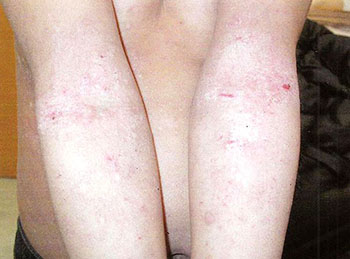Skin disorders common among Inuit: MD
Physician recommends creams, avoiding soap

Itchy, sore and red: this is what a skin rash commonly seen in the Baffin region looks like. The rash, which is linked to allergies, can be treated if it’s not severe, said Dr. Robert Jackson, a dermatologist who has visited Nunavut for more than 10 years.

Anyone who suffers from problems with itchy, dry skin in Nunavut’s Baffin region has likely been seen by Dr. Robert Jackson, a dermatologist from the University of Ottawa who has visited Nunavut for more than 10 years. (PHOTO BY JANE GEORGE)
You or someone you know likely suffers from inflamed skin covered with painful fluid-filled bumps that ooze and crust.
Patches of itchy, dry and inflamed skin are common among many Inuit in the Baffin region, and likely among all Nunavummiut, according to Dr. Robert Jackson, a dermatologist from the University of Ottawa who has treated skin disease in the Baffin for more than 10 years.
More than one in three Inuit in the Baffin region have a skin disease, which doctors call “atopic dermatitis,” that is, a skin rash caused by an allergy, said Jackson, who attended the recent International Congress for Circumpolar Health in Yellowknife.
Usually associated with asthma and hay fever, this recurring skin inflammation hasn’t yet been linked to these allergies among Inuit, he said.
But the Arctic’s dry climate and a genetic tendency towards this skin disease among Inuit contribute to making this condition worse, he said.
The rashes usually start in infancy and early childhood, although they sometimes persist among teenagers and adults.
If left untreated, the chronic inflammation can cause the skin to thicken and become seriously infected.
Jackson has seen more than 2,200 patients in the Baffin over 11 years.
During this period, he’s treated nearly 500 cases of atopic dermatitis, which is particularly widespread in Arctic Bay and Clyde River, he said.
Treatment can include medicinal creams.
To treat the rashes at home, Jackson also recommends daily bathing for five to 10 minutes in lukewarm water with some kind of unscented bath oil.
“Don’t use soap” is his advice.
After bathing, pat yourself or your child dry very gently, and apply moisturizing oil. You can do this several times a day, he said.
But this advice isn’t always easy for people who live in overcrowded homes to follow, he acknowledged.
Often Jackson doesn’t see patients until they are severely affected and some have even had to be sent south for hospital treatment due to infection.
Jackson said there’s still a lot of misunderstanding and a lack of knowledge in Nunavut about skin diseases, which also include psoriasis, eczema and acne.
He said a patient in the Baffin region who suffered from eczema was reportedly fired because of because her employers thought her skin condition was contagious.
Nearly all skin rashes are not contagious, although Jackson has seen some rare virus-related skin conditions in the Baffin, such as skin lesions from the virus HTLV-1, warts in the mouth from Heck’s disease and raised bumps due to classic Kaposi’s sarcoma, usually a disease of eastern Mediterranean and Ashkenazi Jewish elderly men.

This child suffers from a bad case of atopic dermatitis, revealed by the itchy, painful crusts on his arm.





(0) Comments